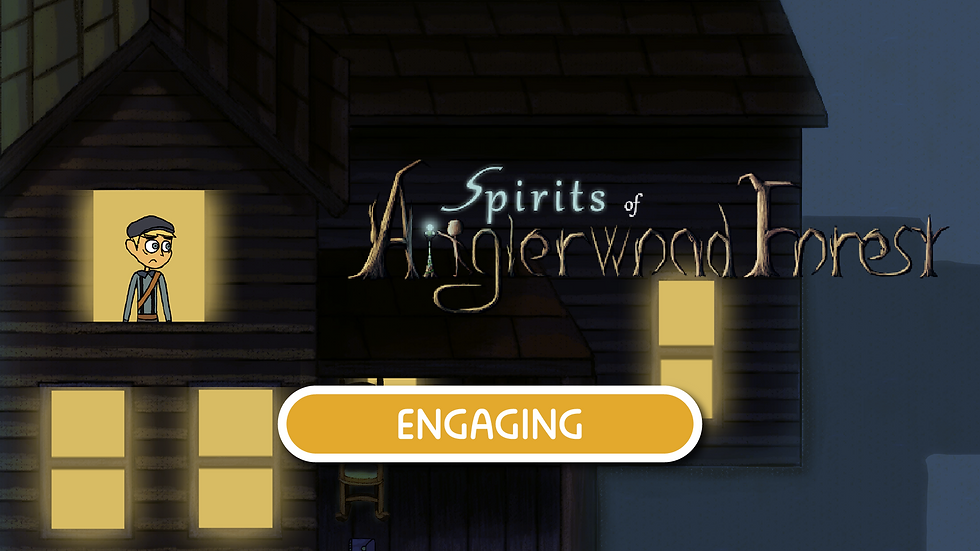Spirits of Anglerwood Forest Review – A challenging, spooky adventure.
- Tim C.

- Mar 18, 2020
- 4 min read
Updated: May 5, 2020
SPOILER-FREE REVIEW

Combining accomplished art and sound design with some challenging gameplay, Spirits of Anglerwood Forest is a charming and spooky adventure despite some inconsistencies.
In recent years, the landscape of gaming has changed drastically, as the boisterous console wars wind down and video games gain greater recognition as an art form capable of delivering narrative experiences that go toe-to-toe with the very best movies and TV shows. Mobile gaming too has changed for the better, and Spirits of Anglerwood Forest is very much emblematic of that change. While it’s not quite that killer exclusive app, it still promises some good things for the future of mobile gaming.

Set in rural America sometime near the turn of the 20th Century, Spirits of Anglerwood Forest tells the tale of a boy named Edgar, whose parents mysteriously vanish one day after his father instructs him in a mystical ritual designed to keep evil spirits inhabiting the nearby forest at bay. As the only one who can see these malignant entities, Edgar must journey deep into the heart of the forest, which has claimed many souls over the decades, in order to save them.

It’s a familiar yarn, though that does little to spoil what the game has to offer. A pivot towards Lovecraftian horror is hardly typical territory for mobile gaming, and I found myself pleasantly surprised by the hidden depth that gradually reveals itself. Over its twelve chapters, the game builds up a tense atmosphere, straddling full-blown Lovecraftian horror and an oddly charming Tim Burton-esque style creepiness. These two different approaches to horror are strange bedfellows but the game ensures that its story and its art style are never at odds with one another. The game takes time to flesh out its side characters, though at times, there isn’t really much to do. You can chat with the inhabitants of its towns during the day, but nothing comes of it and the world winds up feeling a little empty.

It’s bolstered by a fantastic art style and animation, which act as super strength glue binding everything together into a coherent adventure. It looks like a children’s storybook brought to life by mischievous magic: a world locked in a perpetual autumn during the day, with rich shades of orange, brown and gold, while at night, the world shifts into darker shades of blue, green and grey. Trapped in the depths of the forest, you come to believe that something supernatural really is lurking within. It’s effortlessly foreboding and oddly reminiscent of the dark, yet whimsical environments of Maurice Sendak’s Where the Wild Things Are. The soundtrack matches this change: lively saloon music by day becomes almost melodramatically operatic music at night. The game’s sound effects are lovely and rich, lending gravitas to every lantern Edgar lights and every salt circle he lays, transforming the game into a top-notch audiovisual experience.

It also offers some challenging gameplay. Edgar has to collect sticks from all the lanterns scattered around a level during the day and at night, he has to perform the ritual: snapping the branches of a tree with special properties to fuel for the lanterns before running around them three times to form circles of salt. The challenge is to light every lantern without getting caught by the evil spirit that pursues Edgar. The rules? You can only carry one branch at a time, and you only carry a limited amount of salt, which needs to be refilled. Being chased by the spirit is a real adrenaline rush, given that you can only evade it by running away or by dropping a temporary salt circle to ward it off. Getting grabbed by it sets you back to the start of the night, so Soulsborne fans will find something to appreciate in the challenge of trying to light eight lanterns scattered around a veritable labyrinth without getting caught.

The game’s levels become complex mazes where new paths open up overnight, challenging your memory and your ability to improvise new strategies on the spot. You control Edgar by swiping a path and his movement is usually smooth, though I did encounter minor pathing glitches where he got stuck on terrain while trying to move forward. I also got stuck: in my case it was midway through the game after a sudden spike in difficulty. As with many challenging games, mileage will vary; if you like games that let you take it easy, then this will just frustrate you. To its credit, its core gameplay loop is solid, and it occasionally shakes things up by adding temporary new mechanics, like a shadow person that can light a lantern on the opposite bank of a river at the same time as Edgar. Disappointingly, these are one-time introductions rather than permanent additions and aren’t used to level the playing field as the stages get tougher. They’re introduced in one stage, only to vanish entirely in the next.

Despite its flaws, I genuinely enjoyed Spirits of Anglerwood Forest. From a purely technical standpoint, its unique gameplay loop manages to tap into the energy and style that so attracts people to games like Dark Souls, while successfully adapting it for mobile devices. That, alongside with its impressive visual and sound design, makes it an excellent debut game, and one that promises good things for its genre as a whole.
This review was completed courtesy of a game code
sent to us by developer Mike Braverman.
Our site policy is to remain honest, independent and unbiased: check it out here.







Comments